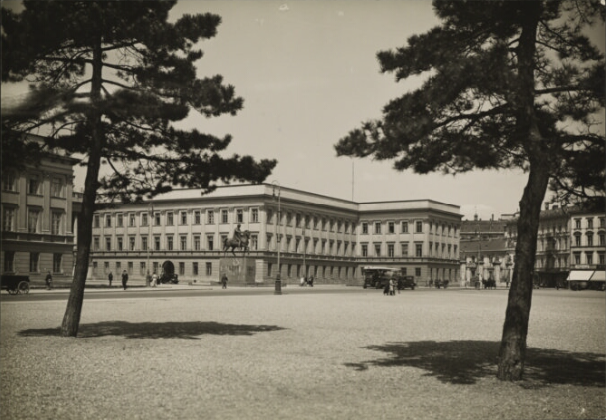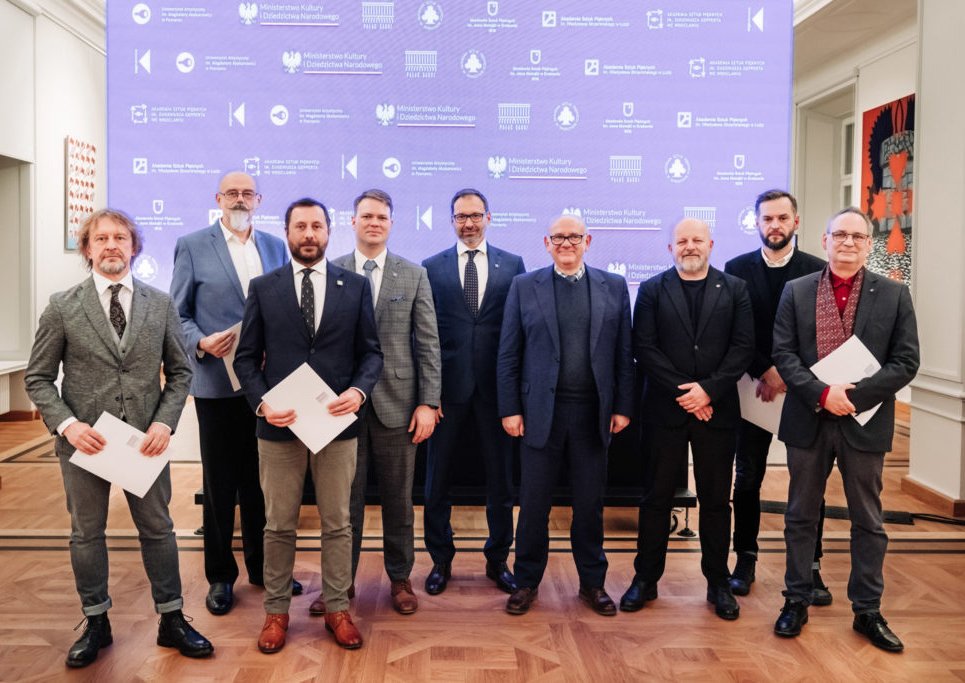August 2023: mid-year review of the Pałac Saski sp. z o.o. activities
The Saski Palace, the Brühl Palace and the townhouses at 6, 8 and 10/12 Królewska Street are the subject of the project to rebuild the western frontage of Piłsudski Square in Warsaw which has been ongoing for a year and a half now. The remnants of the Saski Palace were uncovered during the first months after the launch of Pałac Saski sp. z o.o. – the company responsible for the entire project. Currently, the fieldwork focuses on the site of the former Brühl Palace, where archaeologists are exploring its relics. A competition is also underway to develop an architectural and landscaping concept for the rebuilding of a complex of palaces and townhouses, with a first stage which has just been completed.
Architectural competition
Pursuant to the Act of August 11, 2021 on the preparation and implementation of the reconstruction the Saski Palace, the Brühl Palace and townhouses on Królewska Street in Warsaw (Journal of Laws of 2021, item 1551), the external architectural shape of the restored buildings will be consistent with that in existence on the last day before the outbreak of World War II, i.e. on August 31, 1939. However, the interiors of the buildings need to be adapted to modern safety requirements, as set forth in the construction law, and to the needs of the institutions which are planned to be located in the buildings. It is therefore necessary to develop an architectural and landscaping concept which will be selected in the course of an international architectural competition.
The competition notice was published on March 27, 2023 in the Tenders Electronic Daily - the Supplement to the Official Journal of the EU. Submissions were open to both Polish and foreign architectural firms or consortia. The competition is operated by the Association of Polish Architects (SARP), a subject matter expert with extensive experience. During the qualification phase, experience and technical capabilities of the entities participating in the two-stage procedure were verified. Eleven architectural studios were then qualified for the first stage of the competition and embarked on preparing and submitting their studies. Next, the anonymized works were evaluated by a 12-member jury which qualified 5 participants to continue to the next stage of the procedure. In the second stage, the selected studios will submit their concepts, and the authors of the best proposal will be announced, in accordance with the time schedule adopted, as early as on October 12, 2023.
Archaeological work on the grounds of the Brühl Palace
In June, work commenced on the site of the former Brühl Palace. First, came the sappers to clear the area. Already in the first days of work they found such relics as shells from a Mauser-type rifle and a fragment of an eagle emblem from a soldier's cap. The consortium responsible for conducting the archaeological survey - formed by the Society of Antiquaries, the State Archaeological Museum in Warsaw and the Jardźwig company - had to prepare the site for further operations by taking due care of the local greenery. As plant protection is an absolute priority for us, all six young trees were saved from being cut down. The saplings were properly secured, their roots dug up, and then replanted. The trees are now growing in a new location next to the Monument to the Warsaw Heroes, also known as the Warsaw Nike, where they are regularly watered and looked after by specialists.

On July 3, 2023, the digging began: under the supervision of archaeologists, excavators started removing turf, carefully uncovering the first fragments of the walls of the buildings and the courtyard of the former headquarters of the Ministry of Foreign Affairs. After removing the rubble backfill from each specific section of the site, archaeologists proceeded with careful manual work. They will keep exploring the subsequent cultural layers of the site until the end of the year and completely uncover the nearly 4,500 square meters of the area in the process. The relics of the palace will be then inventoried, as will be the artifacts found between the walls, with the latter additionally undergoing preliminary conservation.

As with the sappers, the archaeologists also discovered their treasures very quickly. During the second week of excavations, parts of the column bases, a stone plaque with Roman numerals, fragments of facade ornaments and a sculpture niche saw the light of day after nearly 80 years. However, the most interesting find so far – excavated from under the rubble on July 13 of this year – is a partially preserved statue with an inscription on its pedestal which reads “GLORY”. Interestingly, a similar statue bearing the same inscription can be found not far away, along the main avenue of the Saxon Garden. A thorough conservation analysis will be needed learn if the uncovered lower part of the sister monument is a Rococo era original or a later copy.
Architectural analysis
Reconstruction of the external appearance of the complex of palaces and townhouses on Piłsudski Square that existed on the eve of the outbreak of World War II poses a significant challenge. The major issues are the relative scarcity of photo cameras at the time and the enormity of the war-inflicted damage suffered by the Polish archives. With that in mind, archival research was one of the first tasks undertaken after establishing of Pałac Saski sp. z o.o., which is the company in charge of the entire project. Cooperation with more than 20 institutions, such as the Warsaw Museum, the Central Military Archives and the State Archives in Dresden, has resulted in the acquisition of approximately 4,000 copies of archival data. of photos, old zoning plans, drawings, but also cost estimates and bills evidencing specific activities performed in the palaces and townhouses.

The collected artifacts were passed to the team of architects and historians. They conducted a detailed architectural analysis of the historic buildings comprising the western frontage of Piłsudski Square to learn more about the appearance of the facades and decorations, as well as the surrounding area. In their study, the specialists also included information on construction materials and manufacturing techniques applied to the buildings.
Reconstruction of sculpture decorations
The remnants of the Brühl Palace uncovered during the ongoing archaeological work are not the only surviving parts of the building. The collections of the Museum of the Earth of the State Academy of Sciences, the Museum of Warsaw and the Faculty of Architecture at the Warsaw University of Technology also own fragments of sculpture decorations that once adorned the palace's facade. Thanks to a fruitful cooperation with these institutions, the conservators could analyze the preserved elements. The specialists verified the state of the relics and evaluated them for potential reincorporation into the facade of the reconstructed building.

A program aiming to reconstruct the sculptures of the entire complex of palaces and townhouses, unprecedented in its scope, is being developed as well. To draw up such a program, the Pałac Saski company has partnered with national art universities and academies with sculpture departments. The entities that signed relevant letters of intent include the Academies of Fine Arts in Gdańsk, Katowice, Kraków, Łódź, Warsaw and Wrocław, as well as the University of Arts in Poznań.
Saxon Garden Festival
Saxon Garden is one of the most popular parks in Warsaw. Originally a royal garden, the Saxon Garden was opened to the public, on May 27, 1727, by the decision of Augustus II the Strong. Its history is directly linked to the Saski and Brühl palaces and the neighboring townhouses on Królewska Street. Hence, on May 27, we celebrated the anniversary of the opening of the park and invited Warsaw residents and guests of the capital city to visit its charming alleys. The program of the event alluded to another period of splendor of the western frontage of Piłsudski Square: the interwar period. It was then that the General Staff along with its intelligence service operated in the Saski Palace, while the Brühl Palace served as the headquarters of the Ministry of Foreign Affairs.

The 2nd edition of the Saxon Garden Festival was brimming with the atmosphere of the times gone by. Those participating in the open-air event had an opportunity to ride penny-farthings, learn about the items used by traditional shoemakers, barbers or doctors, and admire the exhibits on display in cozy shops with porcelain, travel goods and radios. The festivities opened with a lavish parade featuring historical reconstruction groups, orchestras and other artists. There were also other parades held throughout the day on the streets surrounding the Saxon Garden. Vintage cars passed every hour, then returned to the parking lot in front of the Europejski Hotel to be admired. The finale was a dance at the garden pond, where on a wooden dance floor the participants of the festivities let themselves be carried away by the rhythms of Janusz Prusinowski Kompania and the Warszawska Orkiestra Sentymentalna. According to the Warsaw Police estimates, approximately 40,000 people attended the event.
International Poster Biennale
Once reconstructed, the Saski Palace will be accessible to all, as it will house public institutions and hold concerts and exhibitions. To provide visitors with a preview of the palace's future functions, we turned the site fence into an urban art gallery. For example, in October 2022, it housed the "Fragments of the Past" exhibition. The display showed archival photographs and information on the history of the site, as well as artifacts discovered during the archaeological excavations of 2006 and 2008. In June of this year, the display was replaced with another exhibition which is now available online.

Currently, there is contemporary art on display. Thanks to cooperation with the Academy of Fine Arts in Warsaw, the "Home" exhibition appeared on the fence. The display was organized as part of the 28th International Poster Biennale in Warsaw. The biennale was first held in 1966 at the Central Bureau of Art Exhibitions, or today's Zachęta National Art Gallery.
Conferences
The nature of the reconstruction of the historical western frontage of Warsaw’s Piłsudski Square calls for engagement of experts from many different areas of academia - including architects, heritage conservators and historians. An early opportunity to discuss the topic with academics came in June. Together with the University of Warsaw and the Royal Łazienki Museum, we organized the second edition of the interdisciplinary "Echoes of Antiquity” conference. This international event was attended by scholars focusing on the tradition of ancient art and the reception of Antiquity. As the Saski Palace is an interesting example of classicist style, the conference concluded with a tour of its relics.
Preparations for the next scientific forum, to be held on September 20-21, are already underway. The "Rebuilding What Was Lost. Current Challenges in Restoring and Reconstructing Architectural Heritage" conference is co-organized with the the Academy of Fine Arts in Warsaw. The partners of the event are the Association of Polish Architects SARP and the National Institute for Monument Conservation. Among the topics discussed will be the added value of architectural restoration or the challenges involved in the process of rebuilding. Scholars will also explore the challenges of incorporating historic architecture in the modern urban fabric, or the issue of disappearing crafts and their potential use in contemporary reconstructions.